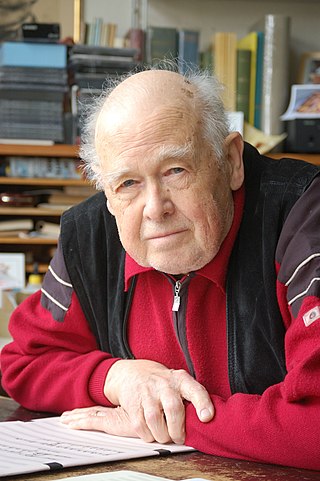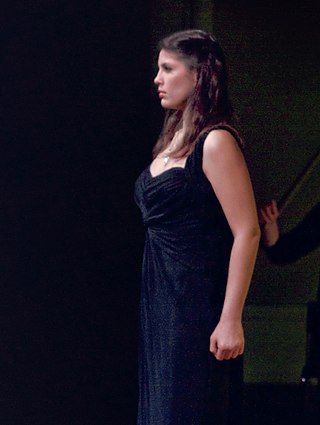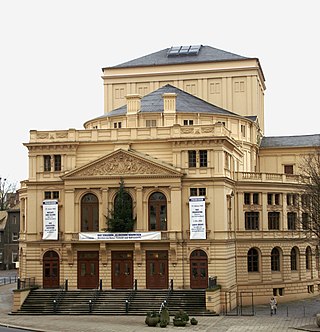
Detmold is a city in North Rhine-Westphalia, Germany, with a population of 74,835. It was the capital of the small Principality of Lippe from 1468 until 1918 and then of the Free State of Lippe until 1947. Today it is the administrative center of the district of Lippe and of the Regierungsbezirk Detmold. The Church of Lippe has its central administration located in Detmold. The Reformed Redeemer Church is the preaching venue of the state superintendent of the Lippe church.

Die tödlichen Wünsche, Op. 27, is an opera by Giselher Klebe who also wrote the libretto based on La Peau de chagrin by Honoré de Balzac. It consists of fifteen lyrical scenes in three acts. It premiered on 14 June 1959 at the Deutsche Oper am Rhein in Düsseldorf, conducted by Reinhard Peters, and was published by Boosey & Hawkes. The opera was revived in 2006 at the Landestheater Detmold on the occasion of the composer's 80th birthday.

The Nordwestdeutsche Philharmonie is a German symphony orchestra based in Herford. Founded in 1950, the orchestra is one of the Landesorchester of the state of North Rhine-Westphalia, along with the Philharmonie Südwestfalen and the Landesjugendorchester NRW. The orchestra is funded partly by the state of North Rhine-Westphalia and an association of communities in the region Ostwestfalen-Lippe. Members of the association are the cities Bad Salzuflen, Bünde, Detmold, Herford, Lemgo, Minden and Paderborn and the districts Herford und Lippe. The orchestra gives concerts in such venues as the Konzerthalle Bad Salzuflen and the Stadttheater Minden.

Hans Johann Karl Kiewning was a German archive director, library director, historian, writer and painter.

The Church of Lippe is a Reformed (Calvinist) member church of the Protestant Church in Germany that covers what used to be the Principality of Lippe.

Detmold Station is the main train station of the city of Detmold in the German state of North Rhine-Westphalia. It was opened in 1880. It is classified by Deutsche Bahn as a category 5 station, and has two platform tracks. The station building was thoroughly renovated in 2006 and 2007.
Gerd Nienstedt was a German and Austrian opera singer, bass and bass-baritone. After an international career at major opera houses and the Bayreuth Festival, he was also a theatre director, stage director and academic voice teacher.

Detmold child is the name of a mummy found in Peru. The mummy has been identified to be about 6,500 years old, making it one of the oldest preserved mummies ever found. It was named The Detmold child by its owners Lippisches Landesmuseum in Detmold, in North Rhine-Westphalia, Germany.
Gerhild Romberger is a German mezzo-soprano and contralto concert singer.

Megan Marie Hart is an American operatic soprano from Eugene, Oregon, performing in leading operatic roles and concerts in America and Europe.

Minna Lammert, also Minna Lammert-Tamm and Minna Tamm, was a German operatic mezzo-soprano. For decades a singer of the Hoftheater in Berlin, she appeared in the first complete performance of Wagner's Der Ring des Nibelungen at the first Bayreuth Festival in 1876 as one of the Rhinemaidens.

Ewandro Stenzowski is a Brazilian operatic tenor and veteran of the Brazilian Marine Corps. He appeared in concerts and leading tenor roles in South America and Europe.
The term Landesbühne or Landestheater is added to the name of some publicly owned theatre companies in Germany and Austria. These companies have a mandate to perform in areas without public theatres. Less than half of performances usually take place at the seat of a Landesbühne, thereby distinguishing them from the so called Stadttheater or Staatstheater. Legal control can lie with the respective Bundesland or a collaboration of several municipalities and local authorities. The spectrum of presented productions can be very diverse. The repertoire can include all or parts of the popular disciplines: play, musical theatre, ballet, and children's and youth theatre.
Hatsue Yuasa (湯浅 初枝 Yuasa Hatsue, was a Japanese operatic soprano.
Hermann Thomaschek was a German operatic bass.

The Landestheater Altenburg is a multi-part theatre in Altenburg and part of the Theater Altenburg-Gera. The venues used are the Großes Haus with 500 seats as well as the Heizhaus and the Theater unterm Dach. The general director and managing director since 2011 is Kay Kuntze.
Martin Christian Vogel is a German operatic tenor, singing teacher, Hochschulrektor and theologian.

Traute, Princess of Lippe was a German princess, philanthropist, and biologist. She was a patron of the visual arts, the Princess Pauline Foundation, the City of Detmold, and the District of Lippe. She was the bearer of the Federal Cross of Merit. She was awarded a Crown Cross in gold from the Diakonisches Werk in recognition of her social work.

Princess Elisabeth of Schwarzburg-Rudolstadt was Princess consort of Lippe as wife of Leopold III, Prince of Lippe from 1852 to 1875 and was the child of the reigning Albert, Prince of Schwarzburg-Rudolstadt.
















